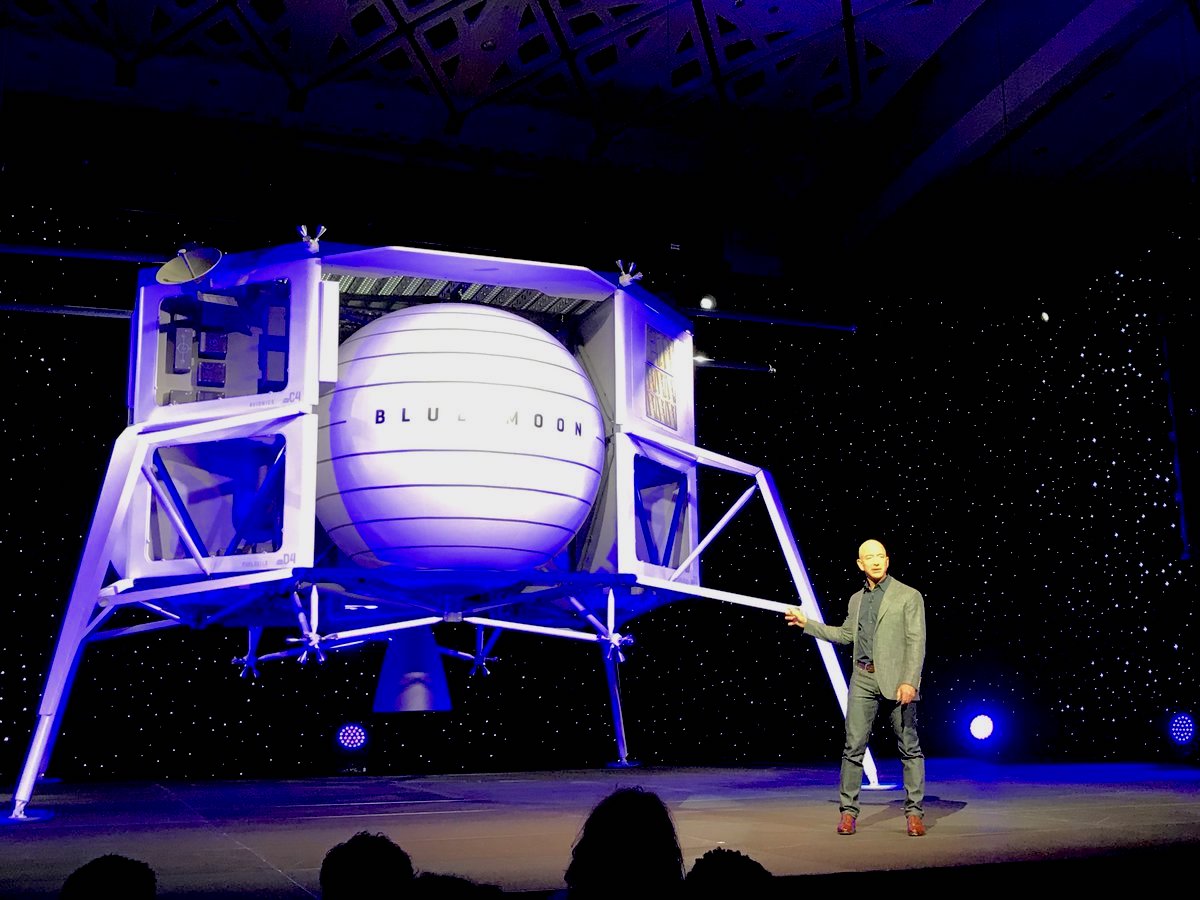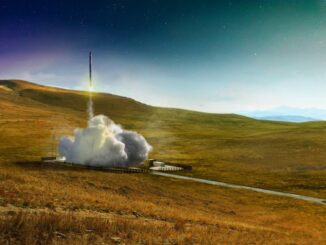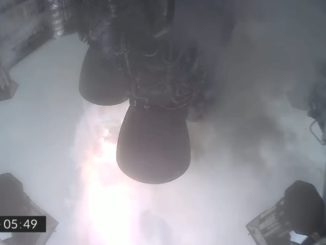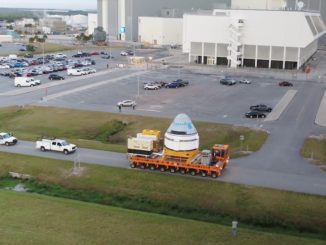
Amazon founder Jeff Bezos, the world’s richest person, discussed his vision for spaceflight and lunar exploration Thursday in Washington, revealing new details about a privately-developed lunar lander he said will help NASA achieve the Trump administration’s goal of returning astronauts to the surface of the moon by 2024.
During an invitation-only event in Washington on Thursday afternoon, Bezos unveiled a full-scale mock-up of the Blue Moon lander, a vehicle designed to initially deliver cargo, and eventually astronauts, to the lunar surface.
“This is Blue Moon,” Bezos said, moments after a curtain dropped to reveal a model of the lander. “We’ve been working on this lander for three years, it’s a very large lander. It’ll soft land in a precise way, 3.6 metric tons (7,936 pounds) onto the lunar surface. The stretched tank variant of it will soft land 6.5 metric tons (14,330 pounds) onto the lunar surface.”
Blue Origin, Bezos’s space company, previously announced the existence of the Blue Moon lander project. But Bezos disclosed additional details about the landing craft Thursday, including a new engine named the BE-7 to power the Blue Moon descent stage.
With Apollo 17 moonwalker Jack Schmitt, NASA officials, scientists, reporters, and school children in the audience, Bezos said the Blue Moon lander could help NASA achieve a goal set by the Trump administration to land astronauts on the moon by 2024.
“I love this,” Bezos said of Vice President Mike Pence’s speech in March announcing the accelerated lunar landing timeline. “It’s the right thing to do … and we can help meet that timeline, but only because we started three years ago. It’s time to go back to the moon, this time to stay.”

Blue Origin’s other main projects are the New Shepard and New Glenn rockets.
The New Shepard, which has flown 11 times from Blue Origin’s test site in West Texas, is a reusable suborbital rocket designed to carry space tourists to edge of space. The single-stage booster, powered by a hydrogen-fueled BE-3 engine, has not yet flown with human passengers, but Bezos said Thursday the first New Shepard launch with humans on-board is scheduled later this year.
The orbital-class New Glenn rocket is set for its inaugural launch in 2021 from Cape Canaveral, using seven methane-fueled BE-4 booster engines. Manufactured in a newly-completed factory near NASA’s Kennedy Space Center in Florida, the New Glenn’s basic two-stage variant will be able to lift up to 45 metric tons — nearly 100,000 pounds — to low Earth orbit, and its first stage will return to land on a ship at sea, using a landing profile similar to the one used by SpaceX’s Falcon 9 rocket boosters.
Blue Origin recently passed the 2,000-employee threshold, and plans to grow to 2,600 employees by the end of the year.
The Blue Moon has four landing legs, which could be folded to allow the spacecraft to fit in the 23-foot-wide (7-meter) payload envelope of Blue Origin’s New Glenn rocket, Bezos said.
The Blue Moon spacecraft design displayed Thursday would serve as a landing vehicle for a range of scientific experiments, cargo pods, and robotic rovers. A stretched version of the Blue Moon with larger fuel tanks would be capable of delivering astronauts to the moon inside a pressurized compartment and an ascent stage to allow the crews to take off again.
“The deck is designed to be a very simple interface so that a great variety of payloads can be placed onto the top deck and secured,” Bezos said.
A davit crane, similar to a device used on naval vessels, will lower equipment from the lander’s top deck to the lunar surface.
Bezos did not say if Blue Origin would develop an ascent stage, or seek a partner for that critical element of a human-rated lunar lander. The stretched version of the Blue Moon described by Bezos could launch on the two-stage version of the New Glenn rocket, according to an industry source.
If a heavier crew module is required, an upsized three-stage New Glenn rocket, or even an expendable version of the launcher, could send more mass the moon, the industry official said.
The BE-7 engine announced Thursday will produce up to 10,000 pounds of thrust at full power, consuming a mixture of super-cold liquid hydrogen and liquid oxygen propellants. The Apollo lunar lander developed in the 1960s used a blend of hydrazine fuel and nitrogen tetroxide, two liquids stored at room temperature that ignite on contact, making for a simpler engine.

Like the Blue Moon lander itself, the BE-7 engine has been in development for around three years, and the BE-7’s first hotfire test is planned this summer, Bezos said.
“It has 10,000 pounds of thrust, and it has very deep throttling capability,” Bezos said. “That’s critical for a lunar descent engine because this lander, when it’s fully loaded with fuel, weighs 33,000 pounds (about 15 metric tons). When it’s done its descent burn, and it’s just about to land, and the fuel is almost gone, it weighs less than 7,000 pounds.
“So to provide the right amount of force on the vehicle with the engine, you need to be able to throttle it way down as the vehicle is getting lighter because it’s burning its own fuel,” he said.
Bezos did not say when the Blue Moon could be ready for its first space mission, or how much it will cost, but he said the BE-7 engine is a “hard problem … that needs still to be solved.”
“These problems that we’re talking about, the kinds of things we’re talking about, we’ve solved them all already for New Shepard,” Bezos said. “It’s very similar. The landing gear, the liquid hydrogen tanks, all those things are solved, even the autonomous descent, and so on. But we need the new (BE-7) engine, and that’s what this is. And it’s very exciting. The team has made incredible progress.”
In a fact sheet released by Blue Origin after Thursday’s announcement, the company said the BE-7 engine will be available for sale to other companies for use on other space vehicles and landers.
NASA and Blue Origin signed a Space Act Agreement in March to support testing of a 3D-printed thrust chamber assembly for the Blue Moon lander at the Marshall Space Flight Center in Alabama.
The content of Bezos’s remarks was closely guarded before Thursday’s announcement. Blue Origin released a picture on Twitter on April 26 that seemingly hinted that the announcement was related to the moon.
The image tweeted by Blue Origin showed the Endurance, the ship used by Antarctic explorer Ernest Shackleton, surrounded by polar pack ice during the attempted Imperial Trans-Antarctic Expedition. The Endurance became stranded in ice and sunk in 1915 before reaching Antarctica.
In his speech in March directing NASA to return humans to the lunar surface by 2024, Pence said the space agency will target a landing at the moon’s South Pole, home to craters with bottoms that never see sunlight.
The permanently-shadowed crater floors are cold traps that measurements from lunar orbit indicate harbor water ice, which could be tapped by future landers or moon bases to generate rocket fuel, electricity and oxygen. At the lunar South Pole, there are also places that see nearly constant sunlight, such as crater rims, providing a site that solar-powered probes could land and operate.
One crater at the lunar South Pole was named for Shackleton, a bowl-shaped basin measuring about 13 miles (21 kilometers) wide and 2.6 miles (4.2 kilometers) deep.
Blue Origin selected liquid hydrogen as the fuel for Blue Moon’s BE-7 engine to allow the lander to eventually be refueled on the lunar surface, using water ice extracted from permanently-shadowed craters.
Liquid hydrogen must be stored at super-cold temperatures near minus 423 degrees Fahrenheit (minus 252 degrees Celsius) to prevent it from boiling off into a gaseous state. The hydrogen fuel that does become a gas will be routed through the lander’s liquid oxygen tanks, also at cryogenic temperatures, to prevent them from getting too warm and boiling off, Bezos said.
A final node in the Blue Moon’s power and propulsion chain will be an accumulator to push the hydrogen into a set of fuel cells to generate electricity.
“We chose hydrogen fuel cells for this vehicle rather than solar cells because we want to be able to survive the lunar night, which you can’t do with solar cells,” Bezos said. “The lunar night is two weeks long, and it gets very cold. And also the fuel cells provide a lot of power. It’s two-and-a-half kilowatts of power, which would (require) a very large solar array.”
The Blue Moon will have laser ranging sensors to map out the craft’s landing zone in real-time, allowing the lander’s computer to compare the terrain to a pre-loaded map to navigate to a safe location, with a precision of 75 feet, or less than 25 meters, Bezos said.
The lander will be able to land safely on inclines of up to 15 degrees, and it will carry a laser communications package to transmit data back to Earth.
“This is an incredible vehicle, and it’s going to the moon,” Bezos said.
After Pence’s speech in March directing NASA to return humans to the moon by 2024, the space agency has kicked off procurement steps to begin seeking concepts for a human-rated lunar lander from industry.
Under the terms of NASA’s most recent lunar lander procurement notice, which the agency released April 26, NASA officials are seeking an integrated moon landing vehicle from commercial industry. NASA originally sought different pieces of a lunar lander, which will include a transfer vehicle, descent stage and an ascent stage, from industry, with the government responsible for integrating the segments into a complete vehicle.
But NASA believes seeking a complete landing craft from industry will be faster, according to Bill Gerstenmaier, associate administrator of the agency’s human exploration and operations directorate.
NASA’s roadmap for a lunar landing by 2024 involves building a mini-space station in lunar orbit called the Gateway. A lunar lander, provided by a commercial company, would then launch to the Gateway, where it would wait for the arrival of a team of NASA astronauts aboard an Orion crew capsule launched aboard NASA’s Space Launch System heavy-lift rocket.
Commercial landers like the Blue Moon could be the answer to NASA’s needs.
NASA expects to select a contractor for the first piece of the Gateway, called the Power and Propulsion Element, as soon as June or July for launch in 2022, with the selection of a manufacturer for a habitat module late this year for a launch in 2023, providing a safe haven for astronauts to live on short stays before and after their landing on the moon.
Meanwhile, NASA continues building the Space Launch System and Orion crew capsule for an unpiloted test flight in lunar orbit in late 2020 or early 2021, a mission that has been delayed by several years by technical woes. The test flight, designated Exploration Mission-1, would be the first launch of the Space Launch System and the first Orion mission beyond Earth orbit.
Exploration Mission-2 would follow in 2022 to carry astronauts around the moon and back to Earth, setting the stage for a lunar landing attempt in 2024, once the initial version of the Gateway is in place in lunar orbit, according to a roadmap outlined by Gerstenmaier on April 30 at a meeting of the National Academies of Sciences, Engineering and Medicine’s Space Studies Board.
Gerstenmaier said Wednesday at a congressional hearing that NASA and the White House expect to release a revised budget proposal to Congress within one or two weeks, with information about the expected cost of the accelerated lunar landing initiative, which would bring forward the schedule for a human landing on the moon from 2028 to 2024.
Other companies are working on human-rated lunar landers, including Lockheed Martin, which unveiled its latest moon landing vehicle concept last month at the Space Symposium in Colorado Springs. The Lockheed Martin lander would reuse computer, life support and propulsion technology from the Orion spacecraft, which Lockheed Martin also builds, in order to get it ready for a moon mission by 2024.

NASA signed agreements in November with nine companies to provide robotic landing services to the moon for experiments and cargo. At the time, industry and NASA officials said the robotic landers could provide technology basis for larger landing craft in the future capable of ferrying humans to and from the lunar surface.
Blue Origin was not among the nine companies that received NASA agreements for robotic landing services last year.
Bezos is taking a different approach to spaceflight than Elon Musk, the billionaire founder and CEO of SpaceX.
SpaceX is working on a deep space exploration vehicle named the Starship, and a reusable first stage booster called the Super Heavy. While Blue Origin’s moon lander appears tailored to NASA’s lunar exploration roadmap, the Starship is a significantly larger vehicle that can serve as a rocket’s upper stage, a deep space transport vehicle, and a planetary lander suitable to the moon, Mars and other worlds.
Musk often talks about extending human civilization to other worlds, but Bezos outlined a long-range vision Thursday involving huge free-floating colonies in space, using miles-long cylinders like those conceptualized by physicist Gerard K. O’Neill in the 1970s.
The colonies could host settlements, manufacturing plants, parks, farms and other diverse landscapes. Bezos said polluting heavy industry could be relocated to the space colonies.
“Earth ends up zoned residential and light industry,” Bezos said. “It’ll be a beautiful place to live.”
“We get to preserve this unique gem of a planet, which is completely irreplaceable,” he said. “There is no plan B.”
“The kids here, and your children and their grandchildren, they’re going to build those O’Neill colonies,” Bezos said. “This generation’s job, my generation’s job, is to build the infrastructure so that you’ll be able to.”
That infrastructure must include lower-cost launch services, enabled by reusable rockets, and the use of in-space resources to supply future space missions and settlements, he said.
“We’re going to build a road to space, and then amazing things will happen, and then you’ll see entrepreneurial creativity, then you’ll see space entrepreneurs create a company in their dorm room,” Bezos said. “That can’t happen today.”
Email the author.
Follow Stephen Clark on Twitter: @StephenClark1.



